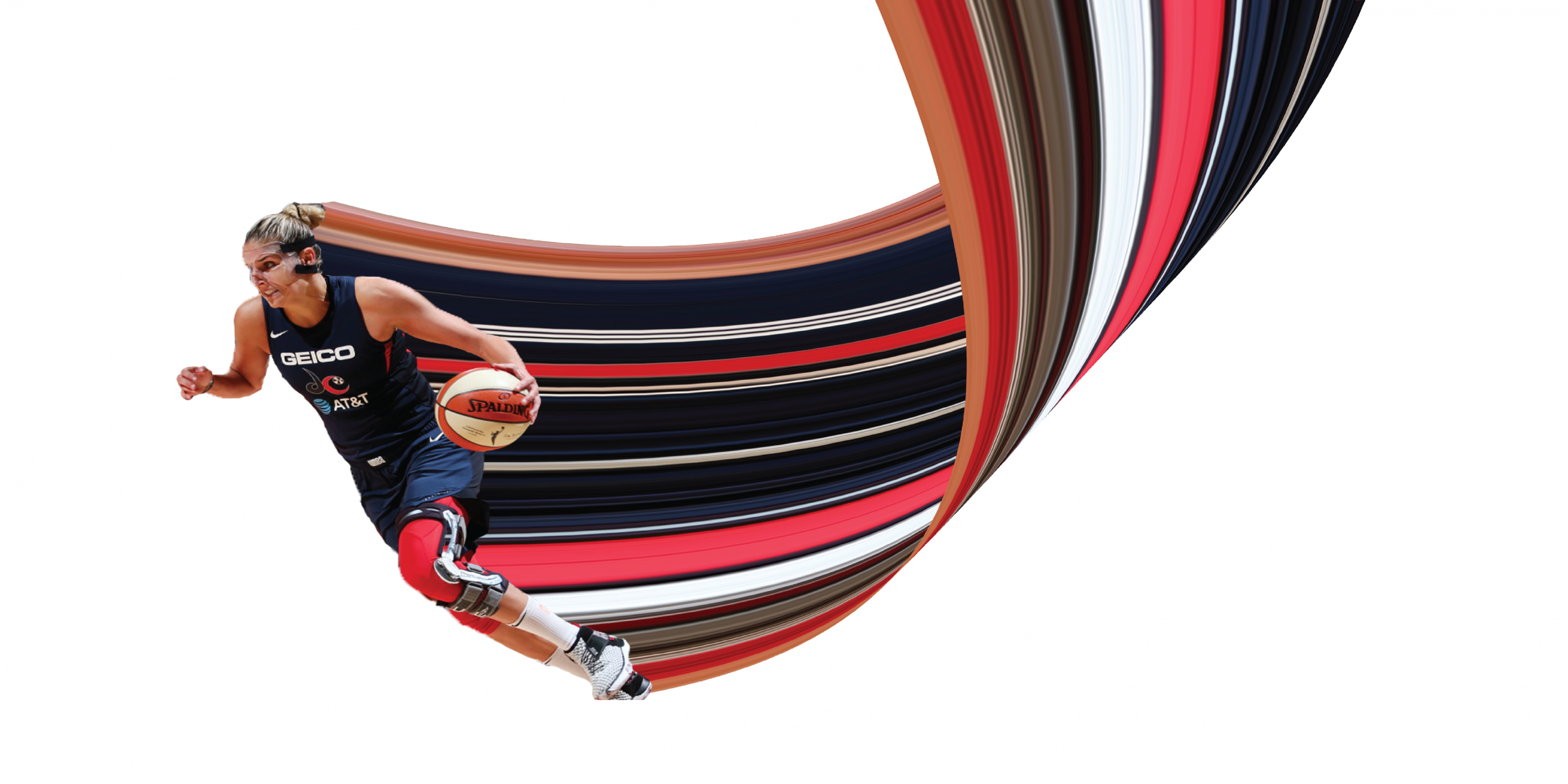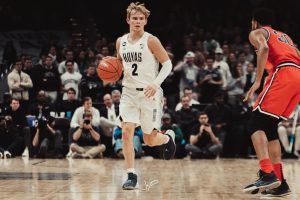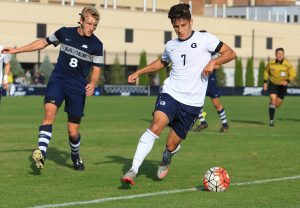Thirty minutes before tipoff on Jan. 10, the Georgetown University Pep Band arrived at McDonough Arena, where exactly 14 Hoya fans were settled in to watch the women’s basketball game. The general feeling amongst the audience was one of excitement. The Hoyas had a rare opportunity to win in their 4-11 season, facing off against the Xavier Musketeers, who have only won once in 14 tries this year.
Despite the fact that women’s games are on campus and free for students, while the men’s team plays at Capital One Arena and season tickets cost $99, there is a stark disparity in attendance. According to the Georgetown Athletics website, the women’s team has averaged just under 419 attendees per home game, compared to the men’s 7,051. For women’s basketball at both the collegiate and professional level, inequalities persist off the court. A lack of visibility for the women’s game has made it difficult to grow audiences and profit margins alike.
Ultimately the women fell to Xavier 85-64, though it was one of their better-attended matchups as more fans arrived throughout the game. Still, barely a third of the arena’s seats were full. Guard Marvellous Osagie-Erese (COL ’20) said low attendance can affect players. “Sometimes our audience attendance is not what we would want it to be.”
Nikki Arwood (COL ’89) played as a guard for Georgetown from 1985 to 1989 and is a regular attendee of Georgetown basketball games. She believes more could be done to boost attendance and bring a more energetic atmosphere to McDonough. “When I go to the men’s games, it’s fun. They do a number of things that are sort of rituals that I can’t wait for. I can’t wait for the T-shirt toss out of a cannon,” Arwood said.
The Georgetown women are not alone in this disparity. In 2019, the Washington Mystics, the District’s Women’s National Basketball Association (WNBA) franchise, moved into the Entertainment and Sports Arena, a roughly 4,200 seat stadium in Capitol Heights. Before the new venue was built, the Mystics played games in Capital One Arena, which holds 20,356 spectators.
The move brought mixed results for the Mystics, who did not respond to requests for comment for this story. In previous years, concerts, construction, and conventions at Capital One forced the team to spend long stretches on the road during the season and play playoff games in college arenas. The new compound ensured a permanent home the team could count on.
But according to industry publication SportsBusiness Daily, the Mystics’s regular-season attendance dropped by more than 25 percent in 2019, averaging 4,546 people per game. Before the move in 2018, the team pulled in an average of 6,136 spectators per regular season game—more fans than Entertainment and Sports Arena can hold. Natalie Weiner, a staff writer for sports blogging network SB Nation, said while choosing between an underfilled stadium and a smaller one at capacity isn’t ideal, it might work in the players’ favor.
“I think sometimes if they can get a small arena that’s actually full, that creates a better atmosphere for the game than to be in a big arena that’s spottily attended,” Weiner said. “Obviously, it’s depressing to have those options, you know? But I think consistency and location is a little bit more important at this point.”
In the 2018–19 season, the Wizards averaged 17,487 spectators per game, according to ESPN. The team went 32-50. In 2019, the Mystics went 26-8, and on Oct. 10, they were crowned WNBA champions for the first time in franchise history after defeating the Connecticut Sun. Yet the team’s average attendance was still a quarter of their male counterparts’, perhaps a result of the lack of long-term investment in the WNBA.
The WNBA debuted in 1997 and was founded through the NBA, which still owns the majority of the league. Though she doesn’t think she could’ve made it to the WNBA, Arwood aspired to play professional basketball before a women’s league even existed.
“I had a brother that was a year older than me. We played basketball all the time, and he talked about being in a pro league. And I always kinda wished I could be in one as well,” Arwood said.
The lack of representation for women in sports Arwood experienced still affects girls today. According to the Women’s Sports Foundation, female athletes quit sports at twice the rate of male ones by age 14. For Weiner, the WNBA’s low profile could contribute to this statistic, at least in basketball. “I do think that the relative lack of visibility and glamor and attention dissuades girls from pursuing sports seriously at a much younger age,” Weiner said. “A girl who’s 10 or 11 might not even know that the WNBA exists, you know? So she might not say ‘I want to grow up and be a professional basketball player.’”
Osagie-Erese pointed to the online success of Georgetown men’s guard Mac McClung (COL ’22), who amassed 600,000 Instagram followers before he even got to campus. She believes the internet could be an outlet to improve visibility for women’s basketball. “If we can foster that same platform and connection for young girls, that’ll give fans more of an opportunity to follow their journey as they go to college and play professional sports.”
At just over 20 years old, the WNBA is a fairly young league, according to David Berri, a sports economist at the University of Southern Utah. “It takes decades to build up a fanbase because typically fanbases are inherited from parents, so you need multiple generations before your fanbase really develops.”
During its first season, the WNBA looked promising. The league had deals with NBC and ESPN and showed their games on primetime television. In 1997 and 1999, the average attendance per regular season game was over 10,000 fans, a mark the league hasn’t hit since. In 2019, the league averaged 6,527 spectators during regular season play. Weiner sees this as a fault of WNBA leadership. “The WNBA was super, super successful in its first few years, but that’s because they were shelling out money to promote it,” said Weiner. “So, I think if we see some willingness to do that again, then there’s a return.”
In October 2018, NBA commissioner Adam Silver told the Associated Press that the WNBA had lost an average of around $10 million every year it had operated, though the league rarely releases financial records.
On Jan. 14, the Players’ Association announced the terms of its new collective bargaining agreement (CBA), which will go into effect beginning with the 2021 season. Notably, the WNBA will finally pay their players 50 percent of the revenue the league generates, the model the NBA uses. Top players can make a salary of up to $215,000, and the average salary will grow to $130,000, a significant step forward. ESPN reported that during the 2018-2019 NBA season, Golden State Warriors guard Stephen Curry made $37,457,154, the most in the league. The minimum salary for a male rookie was $838,464. No WNBA player has ever made seven figures playing for her franchise.
To supplement their income, many WNBA players play abroad in Europe during their offseason. While men can often use their free months to focus on overall health, some women don’t get a break from the game. In April 2019, two months before the start of the WNBA season, 2018 Finals MVP and Seattle Storm forward Breanna Stewart ruptured her right Achilles tendon while playing for Russia’s Dynamo Kursk during the Euroleague championship game. She was out for the entire 2019 season.
For Berri, the league is hurt when stars like Stewart are sidelined by second jobs. “You can’t call yourself the premier league in the world when your premier players aren’t showing out,” he said.
Al Neal, a reporter for People’s World, predicts year-round basketball will eventually take a toll on players’ fitness. “On the WNBA’s side, it’s just bad business,” Neal said. “They are not doing enough to benefit their employees in order to improve the quality of their product.”
Risk of injury is not the only potential consequence the league faces when players go abroad. The day after the Mystics won the championship, the team hosted a rally at the Entertainment and Sports Arena and announced they would wait to host a victory parade until the spring because players had commitments to international leagues. To Berri, losing players in the offseason hinders the WNBA’s ability to build a fanbase.
“You are promoting the league when the season happens, but when the season ends, the players vanish, and they’re not available anymore,” Berri said. “It’s an impediment to the growth to your league.”
***
On June 24, 2019, Indiana Fever center Natalie Achonwa was tired. Her team had just fallen to the Seattle Storm 61-65. It was 12:50 a.m., and they were boarding a commercial airline flight to Atlanta, where they would make a connection to return to Indiana to face off against the Minnesota Lynx the following day. Their original flight had been delayed and then they had to deboard due to technical issues. By the time they arrived in Atlanta, they’d slept on the plane, missed their connecting flight, and couldn’t find a flight to Indiana with space for a party of 18. Faced with no other option, the Fever boarded a charter bus for the over 500 mile drive back home, arriving in Indianapolis 23 hours before their game the next night.
“WHAT. A. DAY.” Achonwa tweeted. “22 hrs of post-game travel…but, by the grace of God, we made it. #AllForLove.”
The Fever’s odyssey likely would not have been faced by a men’s team, all of whom travel to games in private jets. In the WNBA, all teams are required to travel on commercial airlines per their CBA, a condition that has tangibly affected the league in the past. In 2018, the Las Vegas Aces forfeited a game against the Mystics, citing health concerns after delays turned their commute into a 25-hour trip with little opportunity for sleep. In a release, the Aces said they had conferred with medical professionals and determined that going forward with the scheduled game would put the athletes at higher risk of injury.
“Naturally, the issue of player safety is of paramount concern for all involved in the WNBA,” the statement read. “This issue is bigger than our team, and this one unfortunate set of circumstances, and we look forward to being a part of future discourse in the hope of preventing such incidents in the future.”
***
Walk into the DuPont Circle Metro station, and a screen is prominently displaying different advertisements for entertainment events in the area. Georgetown’s own Omer Yurtseven and Mac McClung are occasionally featured in these ads, encouraging fans to attend men’s basketball games at Capital One. Their faces are recognizable to all those in the District, and this kind of brand recognition increases the visibility of the men’s program as a whole. No matter how many heartbreaking losses the men suffer, the ads continue.This level of stardom does not go unnoticed by Osagie-Erese. “One thing that I love about Georgetown is that they make it a point to make sure we are on an equal playing field, but there are some times where I can see how, with the men’s team, they do probably get a lot of the glory that comes with Georgetown basketball,” she said. “It’s a basketball dynasty, it’s a basketball school.”
Weiner argues that with the advent of Title IX, which requires schools to provide equal access to sports for men and women, the marketing shouldn’t be different. “It’s like the ivory tower, where ideals are prized, to strive for greater things and big ideas, and at a minimum that should be gender equality in the athletics department, right?”
The disparity between the men’s and women’s programs is evident in the way the athletes are marketed. Even when the women’s team has legitimate stars who make it to the WNBA, such as Sugar Rodgers (COL ’13) or Rebekkah Brunson (COL ’04), they don’t gain the same fan following as the men.
“We talked about a Sugar Rodgers—how many people actually knew her even in the D.C. area?” asked Arwood. “She was an exciting player to watch. People should get to know her, her playing style and everything else, because they enjoy coming to watch her.”
In addition to more aggressive marketing, the disparities in alumni outreach between the men’s and women’s program are obvious. Certainly, the men’s team successfully keeps prominent alumni involved in the program, as evidenced by Hall of Famer Alonzo Mourning (COL ’92) coming to support his son Trey (SCS ’19) in a game last season, not to mention Patrick Ewing (COL ’85) coaching the team. Arwood hopes for similar opportunities to support the women’s team.
“I’m not sure we do a good enough job—the women’s program right now—engaging the alumni,” said Arwood.
Ultimately, Weiner believes these improvements are not possible without greater investment from organizations which govern women’s basketball. “Everything that you would need to get more attention essentially costs money,” said Weiner. “I think sometimes people turn to the media and say ‘Well, if the media covered it more, then it would be more popular’, which, sure, maybe. But I think it has to happen on both ends.”
At the Jan. 10 game, Osagie-Erese wasn’t thinking about wage gaps, marketing disparities, or stadium capacity. The Hoyas had yet to score almost a minute and a half into play, and she had the ball. She dribbled past her defender into the paint and took the shot.
“We are some badasses, okay?” said Osagie-Erese. “We work hard. We are just as tough as any man playing basketball.”





